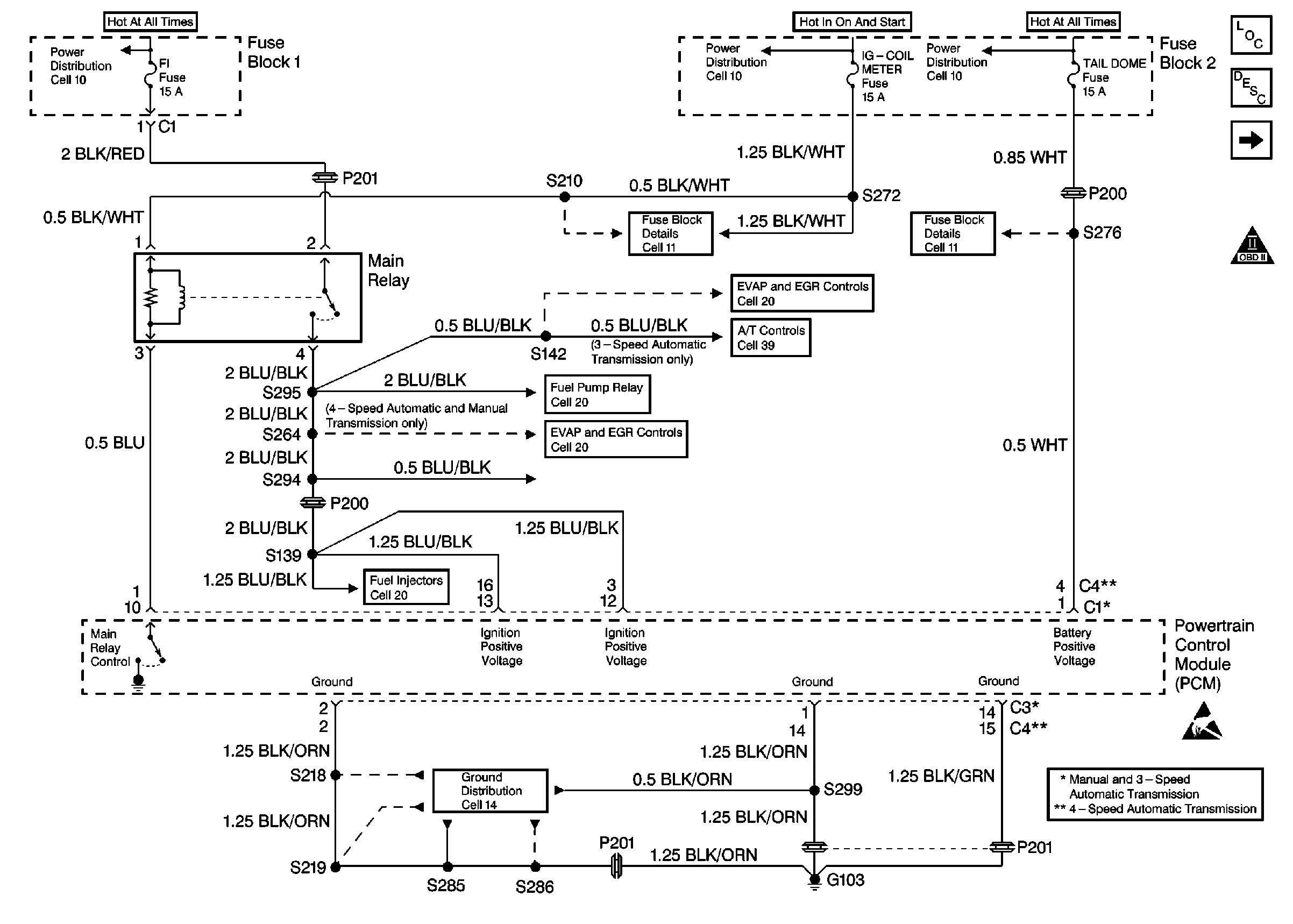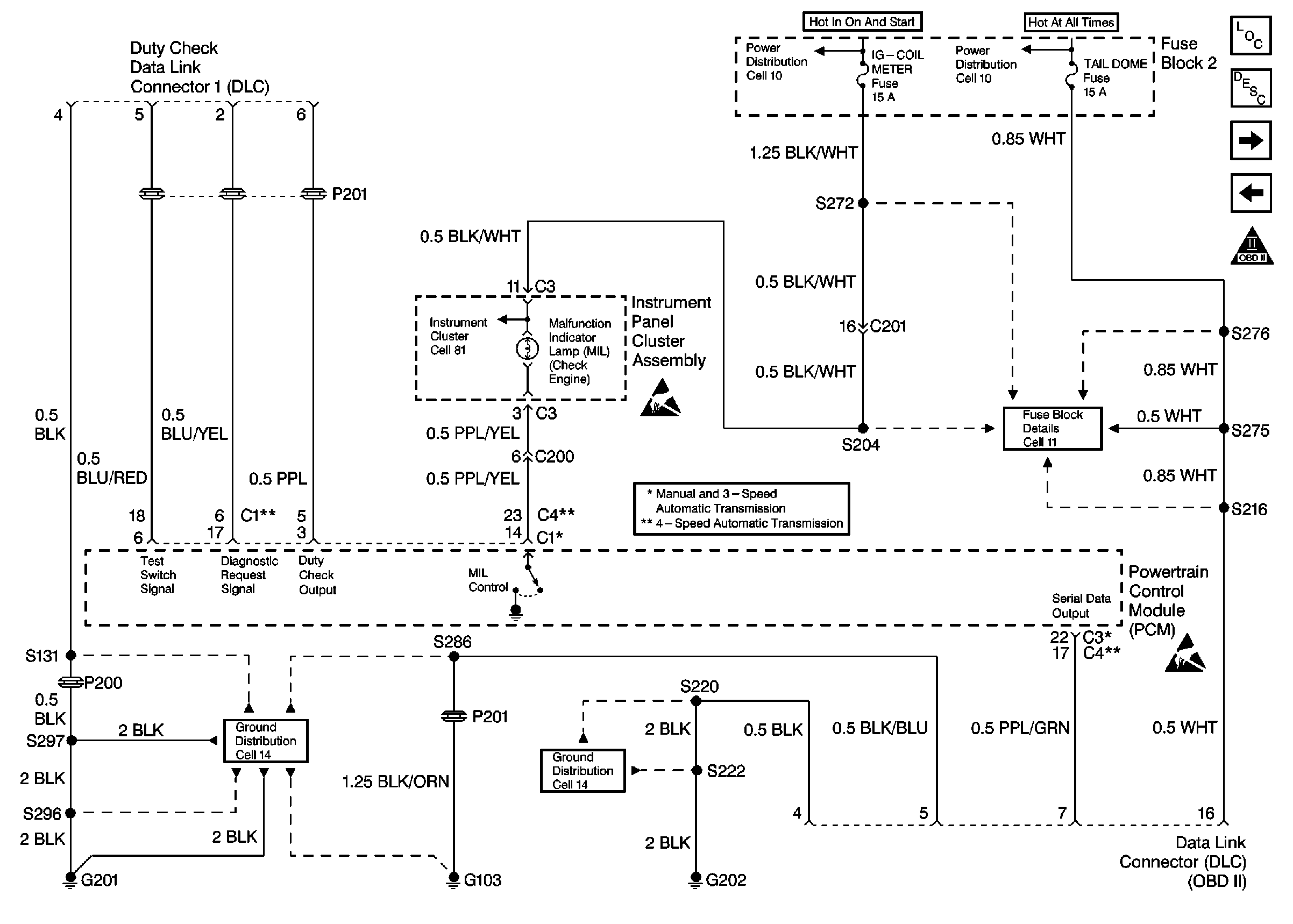Refer to Engine Controls Schematics
Cell 20: Power and Ground

and
Cell 20: MIL and DLC

.
Circuit Description
The provision for communicating with the powertrain control module (PCM) is the data link connector (DLC). It is usually located under the instrument panel. The DLC is used to connect to a scan tool. Some common uses of the scan tool are listed below:
| • | Identifying stored Diagnostic Trouble Codes (DTCs). |
| • | Clearing stored DTCs. |
| • | Storing freeze frame data. |
| • | Reading serial data. |
Diagnostic Aids
Some scan tools may require an external power supply. Make sure your scan tool is using the correct power feed.
Check that the correct application (model year, carline, VIN code) has been selected on the scan tool. If communications still can not be established, try the scan tool on another vehicle to ensure that the scan tool or cables are not the cause of the malfunction.
An intermittent may be caused by a poor connection, rubbed through wire insulation or a wire broken inside the insulation.
Any circuitry, that is suspected as causing an intermittent complaint, should be thoroughly checked for the following:
| • | Backed out terminals. |
| • | Improper mating of terminals. |
| • | Broken electrical connector locks. |
| • | Improperly formed or damaged terminals. |
| • | Faulty terminal to wiring connections. |
| • | Physical damage to the wiring harness. |
| • | Corrosion of electrical connections, splices, or terminals. |
Test Description
The numbers below refer to the step numbers in the Diagnostic Table.
-
The Powertrain (OBD) System Check prompts the technician to complete some basic checks and store the Freeze Frame data on the scan tool if applicable. This creates an electronic copy of the data taken when the fault occurred. The information is then stored in the scan tool for later reference.
-
This step checks to see if the scan tool can establish communications.
-
This step checks for B+ at the DLC battery positive voltage terminal.
-
This step checks for B+ at the DLC serial data terminal.
-
This step checks the ground circuits at the DLC.
-
This step checks for voltage in the ignition positive circuit. If voltage is present at the PCM the malfunction is most likely a faulty main relay or faults in the relay circuitry.
Step | Action | Value(s) | Yes | No | ||||||
|---|---|---|---|---|---|---|---|---|---|---|
Did you perform the Powertrain On-Board Diagnostic (OBD) System Check? | -- | |||||||||
Does the scan tool display engine data? | -- | Go to Diagnostic Aids | ||||||||
3 |
Was a repair necessary? | -- | ||||||||
Is the voltage near the specified value? | B+ | |||||||||
Measure the voltage from terminal 7 of the DLC to ground, with a DMM. Is the voltage near the specified value? | B+ | |||||||||
Probe the DLC terminals 4 and 5 (ground circuit terminals), using a test lamp connected to battery positive voltage. Does the test lamp illuminate for both circuits? | -- | |||||||||
7 | Repair the open or short in the battery circuit between the Fuse Block 2 and the DLC. Is the action complete? | -- | -- | |||||||
8 |
Was a repair necessary? | -- | ||||||||
9 | Repair the open in the DLC ground circuit. Is the action complete? | -- | -- | |||||||
Does the test lamp illuminate at both terminals? | -- | |||||||||
11 |
Was a repair necessary? | -- | ||||||||
12 |
Does the test lamp illuminate? | -- | ||||||||
13 | Probe terminal 1 of the main relay (harness side), using a test lamp connected to ground. Does the test lamp illuminate? | -- | ||||||||
14 |
Does the test lamp illuminate? | -- | ||||||||
15 | Repair the open or a short to ground in the power feed circuit between the main relay and the FI fuse. Is the action complete? | -- | -- | |||||||
16 | Repair the open or the short in the ignition feed circuit between the main relay and the IG-COIL METER fuse. Is the action complete? | -- | -- | |||||||
17 |
Was a repair necessary? | -- | ||||||||
18 | Replace the main relay. Is the action complete? | -- | -- | |||||||
19 | Replace the PCM. Refer to Powertrain Control Module Replacement . Is the action complete. | -- | -- | |||||||
20 | The scan tool is faulty. Refer to the scan tool manual for repair information. Is the action complete? | -- | -- | |||||||
21 | Turn ON the ignition, leaving the engine OFF. Does the scan tool display engine data? | -- | System OK | Go to Diagnostic Aids |
